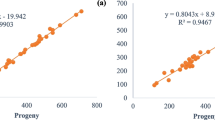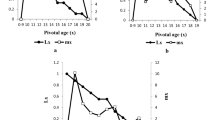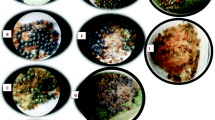Abstract
The release of mass propagated egg parasitoids could be one option to control the lepidopteran pests. The efficiency of the parasitoid Trichogramma evanescens (Westwood) reared on eggs of three different factitious hosts; Sitotroga cerealella, Ephestia kuehniella and Galleria mellonella was studied for controlling bollworm Helicoverpa armigera. Efficiency of Trichogramma was studied by measuring parasitism rates, emergence rates, longevity and sex ratio. Wasps reared from each source were tested on the source host and on the target host, H. armigera under laboratory conditions. Rates of parasitism on H. armigera eggs, emergence rates of parasitoids and their longevity were the highest for wasps reared on H. armigera. Wasps reared on S. cerealella gave comparable rates. However, wasps from E. kuehniella gave the lower rates and G. mellonella gave the lowest ones. Parasitized eggs of H. armigera and S. cerealella produced more parasitoid females than eggs of E. kuehniella and G. mellonella. Results are discussed for magnifying efficiency of the parasitoid in controlling H. armigera in the field.







Similar content being viewed by others
References
Abd El-Hafez A (2001) The effect of egg size of the pink bollworm and some lepidopterous insects on the quality attributes of Trichogramma evanescens and Trichogrammatoidea bactrae. Egypt J Biol Pest Control 11:1–13
Abd El-Hafez A, El-Khayat EF, Shalaby FF, El-Sharkawy MAA (2001) Acceptance and preference of pink bollworm and some lepidopterous eggs for parasitism by Trichogramma. Egypt J Agric Res 79:123–132
Baorong B, Luck RFL, Forster SB, Janssen JAM (1992) The effect of host size on quality attributes of Trichogramma pretiosum. Entomol Exp Appl 64:37–48
Biever KD (1972) Effect of temperatures on the rate of search by Trichogramma and its potential application in field release. Environ Entomol 1:194–197
Boldt PE (1974) Temperature, humidity, and host: effect on rate of search of Trichogrammaevanescens and T. minutum. Ann Entomol Soc Am 67:706–708
Bollhalder F (1999) Trichogramma for wax moth control. Am Bee J 136:711–712
Butler GD, Lopez JD (1980) Trichogramma pretiosum: development in two hosts: in relation to constant and fluctuating temperatures. Ann Entomol Soc Am 73:671–673
Corrigan JE, Laing JE (1994) Effects of the rearing host species and the host species attacked on performance by Trichogramma minutum Riley. Environ Entomol 23:755–760
Fadeyev YN, Greenberg SM (1985) Situation and prospects of Trichogramma utilization in the USSR. Inform. Bull EPS IOBC 11:45–58 (In Russian)
Fitt GP (1989) The ecology of Heliothis in relation to agro ecosystems. Annu Rev Entomol 7:685–688
Greenberg SM, Nordlund DA, Wu Z (1998) Influence of rearing host on adult size and oviposition behavior of mass produced female Trichogramma minutum Riley and Trichogramma pretiosum Riley. Biol Control 11:43–48
Gross HR, Rogers CEJ, Carpenter JE (1996) Development of Archytas marmoratus reared in Galleria mellonella larvae feeding on selected diets. Biol Control 6:158–163
Hassan SA (1998) Commercial use of Trichogramma and other egg parasites in 1995/1996. Egg Parasitoid News 8:1–11
Hassan SA (1993) The mass rearing and utilization of Trichogramma to control lepidopterous pests: achievements and outlook. Pestic Sci 37:387–391
Hoffmann MP, Walker DL, Shelton AM (1995) Biology of Trichogramma ostriniae reared on Ostrinia nubilalis and survey for additional hosts. Entomophaga 40:387–402
Hoffmann MP, Ode PR, Walker DL, Gardner J, Van Nouhuys S, Shelton AM (2001) Performance of Trichogramma ostriniae (Hymenoptera: Trichogrammatidae) reared on factitious hosts, including the target host, Ostrinia nubilalis. Biol Control 21:1–10
Hohmann CL, Luck RF, Oatman ER (1988) A comparison of longevity and fecundity of adult Trichogramma platneri reared from eggs of the cabbage looper and the angoumois grain moth, with and without access to honey. J Econ Entomol 81:1307–1312
Kazmer DJ, Luck W (1991) Female body size, fitness and biological control quality: field experiments with Trichogramma pretiosum. In: Wajnberg E, Vinson SB (eds.) Proceedings of 3rd International symposium of Trichogramma and other egg parasitoids, Les Colloques de INRA, Paris, pp 37–40
King EG (1993) Augmentation of parasites and predators for suppression of arthropod pests. In: Lumsdem RD, Vaughn JL (eds.). Proceedings of Beltsville Symposium ‘‘Pest management: biologically based technologies’’, May 2–6, 1993, MD, pp 90–100
King EG, Bouse LF, Bull DL, Coleman RJ, Dickerson WA, Lewis WJ, Lopez JD, Morrison RK, Phillips JR (1986) Management of Heliothis spp in cotton by augmentative release of Trichogramma pretiosum. J Appl Entomol 101:2–10
Lewis WJ, Nordlund DA, Gross HR Jr, Perkins WD, Knipling EF, Voegele J (1976) Production and performance of Trichogramma reared on the eggs of Heliothis zea and other hosts. Environ Entomol 5:449–451
Li, Li-ying 1994. Worldwide use of Trichogramma for biological control of different Crops: a survey. In: Wajnberg E, Hassan SA (eds). Proceedings of Biological control with egg parasitoids, CAB International, Wallingford, pp 37–54
Marston N, Ertle LR (1973) Host influence on the bionomics of Trichogramma minutum. Ann Entomol Soc Am 66:1155–1162
Ram A, Irulandi V (1989) Influence of host egg on biology of Trichogramma exiguum Pinto, Platner & Oatman (Hym.: Trichogrammatidae). Indian J Entomol 51:361–365
Romeis J, Shanower TG, Zebitz CPW (1997) Acceptance and suitability of ultraviolet-irradiated Helicoverpa armigera eggs for Trichogramma chilonis.J Appl Entomol 121:441–446
Schmidt JM (1994) Host recognition and acceptance by Trichogramma. In: Wajnberg E, Hassan SA (eds) Proceedings of Biological control with egg parasitoids, CAB International, Wallingford, pp 165–200
Shalaby FF, Abd El-Hafez A, El-Khayat EF, El-Sharkawy MAA (2000) Effect of shifting the rearing host on fecundity, emergence and sex-ratio of Trichogramma evanescens and Trichogrammatoidea bactrae. Egypt J Biol Pest Control 10:1–14
Shorey HH, Hala RL (1965) Mass rearing of some noctuid species on a simple artificial medium. J Econ Entomol 58:522–544
Smith S (1996) Biological control with Trichogramma: successes, and potential of their use. Annu Rev Entomol 41:375–406
Stinner RE, Ridgway RL, Morrison RK (1974) Longevity, fecundity, and searching ability of Trichogramma pretiosum reared by three methods. Environ Entomol 3:558–560
van Bergeijk KE, Bigler F, Kaashoek NK, Pak GA (1989) Changes in host acceptance and host suitability as an effect of rearing Trichogramma maidis on a factitious host. Entomol Exp Appl 52:229–238
Wilkinson L, Hill MA, Vang E (2004) SYSTAT: STATISTICS; version 11.0 edition. Evanston, INC
Acknowledgments
My deep thanks are due to ARC, Egypt for providing me Trichogramma source. I’m also greatly indebted to Prof. M. Saleh for his helpful comments on the manuscript. This research was supported financially by project Nr. 7071104 in National Research Center, Egypt.
Author information
Authors and Affiliations
Corresponding author
Additional information
Communicated by Jürgen Gross.
Rights and permissions
About this article
Cite this article
El-Wakeil, N.E. Evaluation of efficiency of Trichogramma evanescens reared on different factitious hosts to control Helicoverpa armigera . J Pest Sci 80, 29–34 (2007). https://doi.org/10.1007/s10340-006-0150-9
Received:
Accepted:
Published:
Issue Date:
DOI: https://doi.org/10.1007/s10340-006-0150-9




